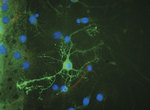Stem cell centre gives hope for stroke damage
 Health Science Health Science
Researchers within the University of Adelaide's new Centre for Stem Cell Research are aiming by the end of this year to show repair in stroke-damaged brains using stem cells taken from adult teeth. The world-leading research using dental pulp stem cells from extracted human teeth and stroke-affected rat brain tissue was outlined as part of the recent launch of the Centre for Stem Cell Research. The focus of the new Centre will be on turning novel basic research into potential life-saving treatments and cures for serious conditions and diseases. The Centre will draw together almost 100 research scientists and 80 research students from 18 research groups based at the University of Adelaide, the Women's and Children's Hospital, the Institute of Medical and Veterinary Sciences (IMVS), Hanson Institute and the Queen Elizabeth Hospital. University of Adelaide Vice-Chancellor and President Professor James McWha said the new Centre would help put South Australian researchers at the forefront of stem cell research in Australia. "The members of the Centre undertake internationally recognised and awarded research on areas such as the isolation of adult and cord blood stem cells, clinical applications including potential cures for stroke damage and cardiac repair, and novel approaches to diseases such as cystic fibrosis and leukaemia," Professor McWha said. Centre Director and University of Adelaide Principal Research Fellow Associate Professor Mark Nottle said: "The focus of the Centre is on translating basic research into clinical and commercial outcomes through collaboration between members and with external partners." The stroke research project is a collaboration between Dr Simon Koblar, University of Adelaide, and Associate Professor Stan Gronthos, IMVS and Hanson Institute. Last month they started injecting adult dental pulp stem cells into stroke-damaged rat brains and should have preliminary results on therapeutic outcomes by the end of the year. "Stroke is the leading cause of disability in Australia with 270,000 Australians left with the residue of strokes every year," Dr Koblar said. "Even if all we can do is get someone's hand function to improve, that would be a magnificent advance." Dental pulp stem cells are highly promising as precursors of replacement neurons (brain cells) because they are easily accessible, can be taken from the patient needing treatment, and they have similar properties to cranial neural crest cells that normally make brain cells and other cranial tissues. The Centre's main aims are to: - undertake and foster world-class stem cell research;
- establish and maintain collaborative links in stem cell research within Australia and internationally;
- provide higher degree and research training opportunities;
- build public awareness of stem cell research in South Australia.
The Centre will provide Early Career Research Fellowships to attract and retain the brightest young minds to Adelaide, and to continue to build the already substantial critical mass of stem cell researchers within Adelaide. Initial funding from the Fellowships has come from the University and Bellberry Limited, a not-for-profit company that manages the only private human research ethics committees in Australia. Story by Robyn Mills
|





